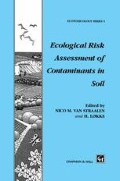Abstract
A main objective of ecotoxicology is to assess the effect of chemicals on ecosystems and to evaluate their potential ecological risk (Moriarty, 1983). Consequently, many theoretical and experimental explorations have been made to provide an adequate basis for the effect assessment of toxicants at the ecosystem level. Much attention is paid to the development of statistical methodologies to extrapolate the results obtained from laboratory toxicity tests to the field situation (Van Straalen and Denneman, 1989; Wagner and Lake, 1991; Aldenberg and Slob, 1993). Basically these methods estimate safe environmental concentrations of hazardous compounds from distribution models of critical effect levels obtained from single-species toxicity tests for different organisms
Access this chapter
Tax calculation will be finalised at checkout
Purchases are for personal use only
Preview
Unable to display preview. Download preview PDF.
References
Aldenberg, T. and Slob, W. (1993) Confidence limits for hazardous concentrations based on logistically distributed NOEC toxicity data. Ecotox. Environ. Safety, 25, 48–63.
Anonymous (1984) Guidelines for Testing of Chemicals Section 2: Effects on biotic systems - 202 Daphnia spp Acute immobilization test and reproduction test. Organization for Economic Cooperation and Development (OECD). ISBN 6412221–4.
Anonymous (1985) EEC Directive 79/831. Annex V. Part C. Methods for the Determination of Ecotoxicity Level I. C(II) 4: Toxicity for earthworms. Artificial soil test. DG X1/128/82.
Baird, D.J., Barber, I. and Calow P. (1990) Clonal variation in general responses of Daphnia magna Straus to toxic stress. I. Chronic life-history effects. Funct. Ecol,4 339–407.
Burgess, R.M. and Morrison, G.E. (1994) A short-exposure, sublethal, sediment toxicity test using the marine bivalve Mulinia lateralis: statistical design and comparative sensitivity. Environ. Toxicol. Chem, 13 571–80.
Charlesworth, B. (1980) Evolution in Age-structured Populations, Cambridge University Press, Cambridge.
Dangerfield, J.M. and Hassall, M. (1992) Phenotypic variation in the breeding phenology of the woodlouse Armadillidium vulgare. Oecologia, 89 140–6.
Fisher, R.A. (1958) The Genetical Theory of Natural Selection, Dover Publications, New York.
Green, D.W.J., Williams, K.A. and Pascoe, D. (1986) The acute and chronic toxicity of cadmium to different life history stages of the freshwater crustacean Asellus aquaticus (L). Arch. Environ. Contam. Toxicol, 15 465–71.
Griffiths, A.J.F., Miller, J.H., Suzuki, D.T. and Lewontin, R.C. (1993) An Introduction to Genetic Analysis, Freeman and Co., New York.
Jorgensen, S.E., Nielsen, S.N. and Jorgensen, L.A. (1991) Handbook of Ecological Parameters and Ecotoxicology, Elsevier Scientific Publishers, Amsterdam.
Kammenga, J.E. (1994) Phenotypic plasticity and fitness consequences in nematodes exposed to toxicants. PhD Thesis, Agricultural University, Wageningen, The Netherlands
Kozlowski, J. (1993) Measuring fitness in life-history studies. Trends Ecol. Evol, 8 84–5.
Lewontin, R.C. (1965) Selection for colonizing ability, in The Genetics of Colonizing Species (eds H.G. Baker and L.G. Stebbings), Academic Press, New York, pp. 77–94.
Maltby, L. and Calow, P. (1989) The application of bioassays in the resolution of envi-ronmental problems; past, present and future. Hydrobiologia, 188/189 65–76.
Marchini, S., Hoglund, M.D., Broderius, S.J. and Tosato, M.L. (1993) Comparison of the susceptibility of daphnids and fish to benzene derivatives. Sci. Tot. Environ Suppl., 799–808.
McKim, J.M. (1985) Early life stage toxicity test, in Fundamentals of Aquatic Toxicology (eds G.M. Rand and S.R. Petrocelli), Hemisphere, Washington, DC, pp. 58–94.
Moriarty, F. (1983) Ecotoxicology, the Study of Pollutants in Ecosystems, Academic Press, London.
Nagel, R., Bresch, H., Caspers, N., Hansen, P.D., Marken, M., Munk, R., Scholz, N. and Ter Höfte B.B. (1991) Effect of 3,4-dichloroaniline on the early life stages of the zebrafish (Brachidanio rerio): results of a comparative laboratory study. Ecotox. Environ. Safety, 21 157–64.
Norberg-King, T.J. (1989) An evaluation of the fathead minnow 7-d subchronic test for estimating chronic toxicity. Environ. Toxicol. Chem, 8 1075–89.
Sibly, R. (1989) What evolution maximizes. Funct. Ecol, 3 129–35.
Sibly, R. and Calow P. (1983) An integrated approach to life-cycle evolution using selective landscapes. J. Theor. Biol, 102 527–47.
Sibly, R. and Calow, P. (1986) Why breeding earlier is always worthwhile. J. Theor. Biol, 123 311–19.
Smith, R.H. (1991) Genetic and phenotypic aspects of life-history evolution in animals. Adv. Ecol. Res, 21 63–120.
Stearns, S.C. (1983) The evolution of life-history traits in mosquitofish since their introduction to Hawaii in 1905: rates of evolution, heritabilities, and developmental plasticities. Amer. Zool, 23 65–76.
Stearns, S.C. (1992) The Evolution of Life-histories, Oxford University Press, Oxford.
Stearns, S.C. and Koella, J.C. (1986) The evolution of phenotypic plasticity in life-history traits: predictions of reaction norms for age and size at maturity. Evolution, 40 893–913.
Stibor, H. (1992) Predator induced life-history shifts in a freshwater cladoceran. Oecologia, 92 162–5.
Thompson, B., Bay, S., Greenstein, D. and Laughlin, J. (1991) Sublethal effects of hydrogen sulfide in sediments on the urchin Lytechinus pictus. Mar. Environ. Res, 31 309–21.
Van Gestel, C.A.M. and Van Straalen, N.M. (1994) Ecotoxicological test systems for terrestrial invertebrates, in Ecotoxicology of Soil Organisms (eds M.H. Donker, H. Eijsackers and F. Heimbach), CRC Press, Lewis Publishers, Boca Raton, FL, pp. 205–51.
Van Straalen, N.M. and Denneman, C.A.J. (1989) Ecotoxicological evaluation of soil quality criteria. Ecotox. Environ. Safety, 18 241–51.
Wagner, C. and Lake, H. (1991) Estimation of ecotoxicological protection levels from NOEC toxicity data. Water Res,25 1237–42.
Williams, D.G. and Black, R.A. (1993) Phenotypic variation in contrasting temperature environments: growth and photosynthesis in Pennisetum setaceum from different altitudes on Hawaii. Funct. Ecol,7, 623–33.
Woltereck, R. (1909) Weitere experimentale Untersuchungen über Artveränderung, speziell über das Wesen quantitativer Artenunterschiede bei Dapniden. Ver. Deutsch. Zool. Gesell, 1909 110–72.
Editor information
Editors and Affiliations
Rights and permissions
Copyright information
© 1997 Springer Science+Business Media Dordrecht
About this chapter
Cite this chapter
Kammenga, J.E., Korthals, G.W., Bongers, T., Bakker, J. (1997). Reaction norms for life history traits as the basis for the evaluation of critical effect levels of toxicants. In: van Straalen, N.M., Løkke, H. (eds) Ecological Risk Assessment of Contaminants in Soil. Springer, Boston, MA. https://doi.org/10.1007/978-1-4615-6361-7_14
Download citation
DOI: https://doi.org/10.1007/978-1-4615-6361-7_14
Publisher Name: Springer, Boston, MA
Print ISBN: 978-1-4613-7922-5
Online ISBN: 978-1-4615-6361-7
eBook Packages: Springer Book Archive

